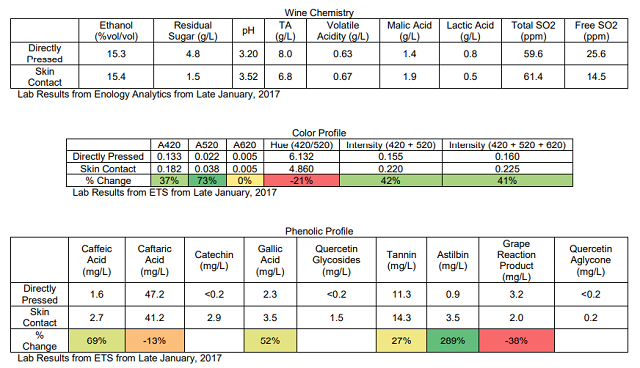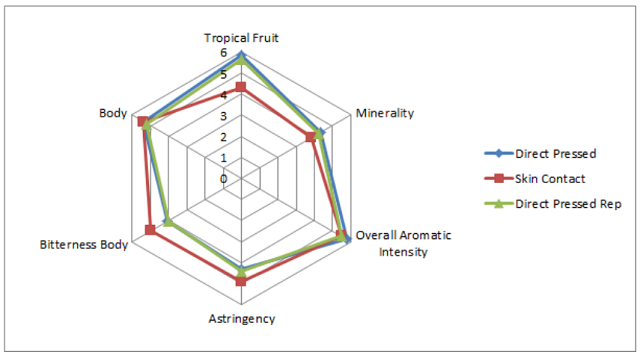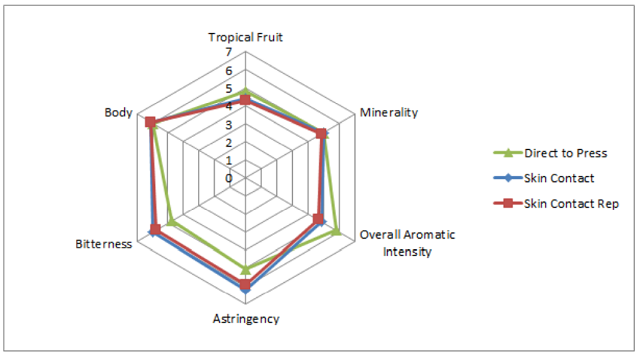Skin Contact vs Traditional Pressing of Petit Manseng (2016)
Corry Craighill
Sunset Hills Vineyard
Summary
This study compares the effects of destemming and cold soaking Petit Manseng Grapes for 6 hours prior to pressing compared to directly pressing whole clusters. Juice produced with skin contact showed higher pH without much change in TA. The wine which underwent skin contact showed much lower TA and much higher pH. Skin contact also increased color intensity, catechin, tannin, caffeic acid, gallic acid, and astilbin. Caftaric acid was decreased by skin contact. This loss in caftaric acid and gain in caffeic acid could be due to equilibrium pressure. Sensory testing found the wines to be significantly different. Direct to Press wines had a slight tendency for higher Tropical Fruit aromatics, and a strong tendency for these wines to have higher Overall Aromatic Intensity. Skin-Contacted wines had strong tendencies towards increased Bitterness, and a slight tendency for higher Astringency. In general, people tended to prefer wines made from direct pressing. Studies of this kind, in conjunction with phenolic fining studies, should be performed in the future.
Introduction
Skin contact in white wines can have many effects on wine qualities, depending on such factors as the length of skin contact time, temperature, skin-to-juice ratio, and mechanical actions on the skins. The skins of many white varieties hold aromatic compounds which release over time into the contacting juice. Skin contact can also release phenolic compounds, which can result in bitterness, astringency, increased oxidation, and browning. The phenolic compounds, as well as other polysaccharide compounds, may also enhance the body of the wine. Skins may also release potassium into the juice, lowering the titratable acidity naturally.
Petit Manseng is a highly aromatic, high Brix, and high acid variety. The high Brix and acid allow for it to be a flexible blending grape; however, on its own this often results in poor balance. Skin contact may be a method to reduce acidity in Petit Manseng wines, but the problems of increased bitterness remain. Much work needs to be done to determine natural ways to help achieve balance in Petit Manseng. This study examines the impact of 6 hours of skin contact on the chemical and sensory qualities of Petit Manseng wine.
Results and Discussion
Note: the wine made from skin contact did not settle well. Juice produced with skin contact showed higher pH without much change in TA. The wine which underwent skin contact showed much lower TA and much higher pH. Skin contact also increased color intensity, catechin, tannin, caffeic acid, gallic acid, and astilbin. Caftaric acid was decreased by skin contact. This loss in caftaric acid and gain in caffeic acid could be due to equilibrium pressure.


For the triangle test, of 31 people who answered, 28 people chose the correct wine (90%), showing a statistically significant difference between wines (p<0.001). These wines were voted to have an average degree difference of 5.1 (out of 10), suggesting that the wines were moderately different. In general, there was a large preference for the directly pressed wine, although comments from the judges were inconclusive and often contradictory. The wine made from skin contact may have been slightly oxidized.

The direct to press wines exhibited a strong tendency towards higher Tropical Fruit aromatics than the wines produced with skin contact. Additionally, the direct to press wines exhibited a strong tendency towards lower Bitterness compared to the skin contact wine.

For the triangle test, of 34 people who answered, 32 people chose the correct wine (94%), showing a statistically significant difference between wines (p<0.001). These wines were voted to have an average degree difference of 6 (out of 10), suggesting that the wines were fairly different. In general, people who answered correctly preferred the Direct to Press wine.

For the March 15 tasting, there was a strong trend for the Direct to Press wine to have higher Overall Aromatic Intensity and lower Bitterness compared to the Skin Contact wine. There was also a slight tendency for the Direct to Press wine for have higher Tropical Fruit aromatics and lower Astringency.

These results suggest that Direct to Press wines have a slight tendency for higher Tropical Fruit aromatics, and a strong tendency for these wines to have higher Overall Aromatic Intensity. Skin-Contacted wines have strong tendencies towards increased Bitterness, and a slight tendency for higher Astringency. In general, people tended to prefer wines made from direct pressing. Studies of this kind, in conjunction with phenolic fining studies, should be performed in the future.
Methods
One lot of Petit Manseng from vineyard V3 was hand picked on 9/18. On 9/19, one ton of this fruit was destemmed into a fermentation T bin and stored in the chiller at 10°C. The pH was monitored over the course of the 6 hours, and it was pressed after the 6 hours. One other ton was whole cluster pressed directly after picking with the addition of 20ppm sulfur dioxide and 15mL per ton CinnFree. Both lots had water added to adjust Brix to approximately 25.4. The lots settled separately for 1 night at 7°C. The juice was racked on 9/21 and NTU was adjusted to 110. The juice was transferred to identical neutral barrels and inoculated with GRE at 15g/hL rehydrated with 30g/hL Go Ferm. 12g/hL DAP was added on 9/24 and again on 9/25. 80g/hL Fermaid K were added from 9/26-9/28. On 12/2, 50 ppm of sulfur dioxide was added. The barrels were stirred once per week for 4 months.
The wines were tasted on March 8 and March 15. For the triangle test and preference analysis, anybody who did not answer the form were removed from consideration for both triangle, degree of difference, and preference. Additionally, anybody who answered the triangle test incorrectly were removed from consideration for degree of difference and preference. Additionally, any data points for preference which did not make sense (such as a person ranking a wine and its replicate at most and least preferred, when they correctly guessed the odd wine) were removed.
In order to balance the data set to perform statistical analysis for descriptive analysis on the March 8 tasting, any judge who had not fully completed the descriptive analysis ratings were removed. In order to then make the amount of judges between groups equivalent, one judge from group 1 was eliminated. This resulted in a final data set of 3 groups, each with 10 judges (considered as replications within groups, and groups were considered as assessors). Data was analyzed using Panel Check V1.4.2. Because this is not a truly statistical set-up, any results which are found to be statistically significant (p<0.05) will be denoted as a “strong trend” or a “strong tendency,” as opposed to general trends or tendencies. The statistical significance here will ignore any other significant effects or interactions which may confound the results (such as a statistically significant interaction of Judge x Wine confounding a significant result from Wine alone). A three way, pseudo-mixed analysis of these interactions was not used to further verify whether the wine result was truly significant. The descriptors used in this study were Tropical Fruit, Minerality, Overall Aromatic Intensity, Astringency, Bitterness, and Body.
The same procedures for data analysis were used on the March 15 tasting. For the descriptive analysis in this tasting, one judge from group 2 was moved to group 1, and another judge was eliminated from group 2, to result in 3 groups each with 8 judges.
